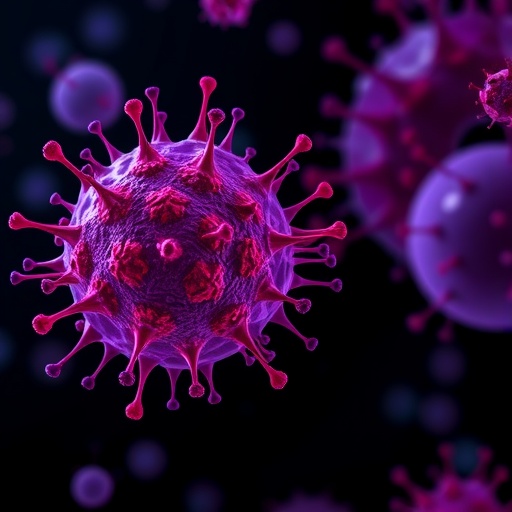Extracellular vesicles (EVs) have emerged as crucial mediators of intercellular communication, particularly in the context of the tumor immune microenvironment. Researchers have been increasingly drawn to explore these small membrane-bound structures, which are secreted by a variety of cell types, including cancerous cells. The significance of EVs does not only lie in their role in normal physiological functions; they also play a pivotal role in pathological conditions, notably in cancer. The intricate relationship between EVs and the immune microenvironment presents a fascinating frontier in biomedical research.
Recent investigations have revealed the sophisticated biogenesis of extracellular vesicles. These structures primarily originate from the endosomal system of cells, where they are formed as intraluminal vesicles within multivesicular bodies. Subsequently, these multivesicular bodies are trafficked to the plasma membrane, where they fuse with the membrane, releasing their contents into the extracellular space. The process of EV formation includes various molecular player interactions, highlighting the complexity of cellular mechanisms involved in their production. This raises pivotal questions about how these biogenic pathways can be manipulated for therapeutic aims.
Understanding the composition of extracellular vesicles is equally important. EVs are laden with a myriad of bioactive molecules, including proteins, lipids, and nucleic acids, which can influence the behavior of target cells. The biological cargo encapsulated within these vesicles can modulate immune responses, alter cell signaling pathways, and even promote tumor progression. For instance, tumor-derived EVs can carry oncogenic transcripts and proteins that may promote immune evasion, thus providing a selective advantage for cancer cells in hostile microenvironments. This ability of EVs to influence immune cells marks them as a potential target in cancer immunotherapy.
The tumor immune microenvironment is highly complex, consisting of various immune cell types, stromal cells, and extracellular matrix components that collectively shape tumor biology and progression. EVs play a critical role in this environment by facilitating communication between tumor cells and immune cells. For instance, EVs released from tumors can interact with dendritic cells, macrophages, and T cells, altering their function and potentially leading to an immunosuppressive environment. This immune modulation can result in the promotion of tumor growth and metastasis, suggesting that dissecting the dynamics of EVs could open new avenues for treatment strategies.
Importantly, the interaction between EVs and immune cells is bidirectional. Not only do tumor-derived EVs modulate the immune response, but immune cells can also produce EVs that exert influence on tumor cells. This multifaceted interaction underscores the need for deeper investigations into how EVs can be harnessed for therapeutic purposes. An understanding of these relationships could lead to innovative strategies for enhancing the efficacy of current immunotherapies.
Given their functional capacities, EVs are being explored as potential biomarkers for cancer diagnosis and prognosis. The unique molecular signatures found within the EVs reflect the physiological state of their cells of origin, making them valuable diagnostic tools. By analyzing the content of circulating EVs in cancer patients, researchers hope to identify specific markers that indicate disease presence, progression, or response to therapy. This liquid biopsy approach could significantly enhance patient management, providing a less invasive alternative to traditional tissue biopsies.
Moreover, targeting the biogenesis pathways of EVs presents another exciting research avenue. By modulating the pathways involved in EV formation and release, scientists may be able to mitigate the immunosuppressive effects of tumor-derived vesicles while enhancing the delivery of therapeutic agents. For example, engineering EVs to carry anti-cancer drugs directly to tumor sites could improve therapeutic efficacy while minimizing systemic side effects. Such advancements could lead to the development of next-generation nanomedicine strategies.
The exploration of EVs in the context of cancer treatment raises intriguing possibilities for personalized medicine. By tailoring EV-based therapies to the specific molecular characteristics of an individual’s tumor, it may be possible to create highly targeted and effective treatment regimens. This approach emphasizes the growing importance of understanding tumor heterogeneity and the unique interactions that define each patient’s disease landscape.
Research into EVs is also extending beyond cancer, with potential applications in other diseases including neurodegenerative disorders and cardiovascular diseases. The broad implications of EV research highlight their versatility as messengers of pathology, capable of influencing various biological systems. This opens the door to a wealth of new therapeutic opportunities that transcend traditional treatment paradigms.
As the scientific community continues to unravel the complexities of extracellular vesicles, it is evident that they hold immense potential in transforming our understanding and treatment of cancer and other diseases. The advancements in isolating, characterizing, and utilizing EVs will undoubtedly provide a foundation for future therapeutic innovations. Scientists are keenly aware that continued exploration of these vehicles will be key to unlocking new strategies for managing cancer and improving patient outcomes.
In summary, the role of extracellular vesicles in the tumor immune microenvironment represents a promising frontier in cancer research. Their ability to modulate immune responses, coupled with their potential as biomarkers and therapeutic agents, underlines the necessity for continued investigation in this domain. As research progresses, the hope is that the insights gained will lead to breakthroughs that improve the lives of patients navigating the challenging landscape of cancer treatment.
In conclusion, extracellular vesicles are no longer just a biological curiosity; they are at the forefront of innovative research with far-reaching implications. The integration of knowledge surrounding their biogenesis and functionality will catalyze the advancement of therapeutic strategies tailored to combat cancer’s complexity. Hence, as the world of science evolves, so too does the understanding of these unassuming yet powerful entities that are revolutionizing the way we approach disease management.
Subject of Research: The biogenesis of extracellular vesicles and their impacts on the tumor immune microenvironment.
Article Title: Extracellular vesicles: biogenesis mechanism and impacts on tumor immune microenvironment.
Article References:
Yeat, N.Y., Chen, RH. Extracellular vesicles: biogenesis mechanism and impacts on tumor immune microenvironment.
J Biomed Sci 32, 85 (2025). https://doi.org/10.1186/s12929-025-01182-2
Image Credits: AI Generated
DOI: 10.1186/s12929-025-01182-2
Keywords: Extracellular vesicles, tumor immune microenvironment, biogenesis, cancer immunotherapy, biomarkers.




